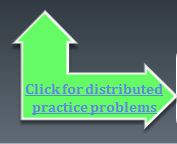Sure, you’ve probably heard “distributed practice” mentioned by your math coach or in a math training, or you’ve seen that hyperlinked arrow on the second slide of each GCG PowerPoint…but you may have found yourself asking, “What’s the point of the problems?” or “How should I use them?”
Let’s cover the basics first. Each GCG in every Grade 1-5 unit (K starts with Unit 4) has a set of accompanying distributed practice problems. The one page (front and back) document has up to 8 problems that relate to the GCG, from the most foundational concepts to those most closely related. They can be found by clicking on the link within the Powerpoint, or in the “k-5 Distributed Practice” folder on the Elementary Math icon.

Now, let’s get to what really matters: “What is the point of these problems?”
Since each of the problem sets incorporates foundational skills for the math concept, they have the potential to provide you with a wealth of information about your students. In order to get the most bang for your buck out of these problems, you will want to incorporate them into your mathematics planning and instructional routine at least one to two weeks prior to teaching the connected GCG. “Why?”, you ask? Well, you want to have enough time to analyze that information that you have collected and use it for planning purposes, of course!
Through analyzing student responses to the distributed practice problems, you can:
• Identify common successes and misconceptions.
• Anticipate student responses when planning for whole group and small group instruction in that GCG.
• Plan activities and questions to support your students and address gaps in learning.
• Use your students’ successes as a jumping off point to make connections to the new content in the GCG.
The key theme of using the distributed practice problems is reviewing the data. So make sure that, however you incorporate the problems into your math instruction, you are able to gather useful information about your students and use that data when planning for the GCG. For example, if you know that the majority of your students do not complete homework or do not put forth as much effort on their work at home, then it might be better to use a distributed practice problem each day as bell-work or a ”do now” to kick off your math block.
For more information on “do now” activities, view the video or visit the websites below:
https://www.teachingchannel.org/videos/class-starting-teaching-strategy
http://teachlikeachampion.com/blog/now-primer/
Pingback: New Resources in grade 5!!! | SMathSmarts